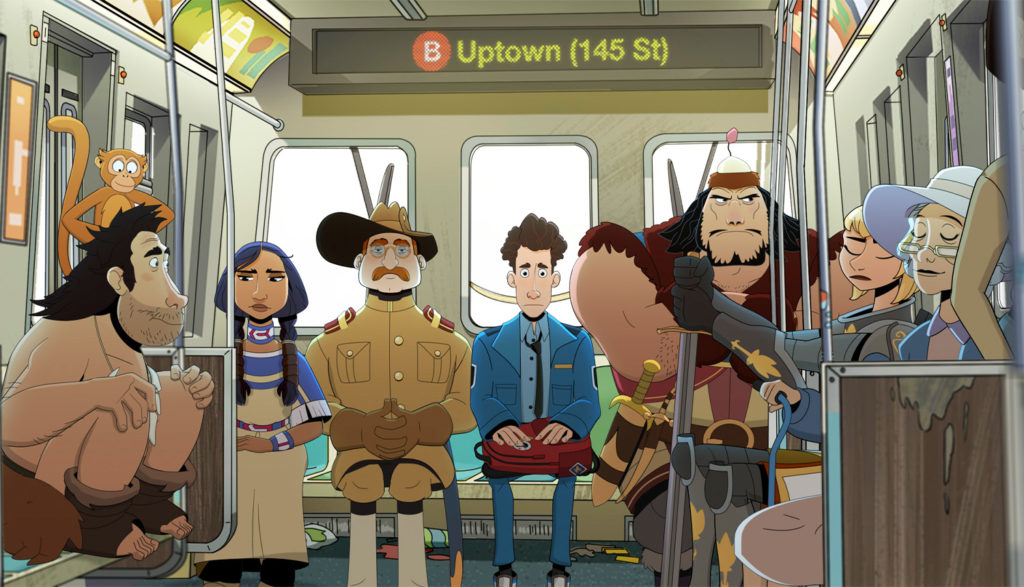
Larry Daley is finally leaving New York City’s Museum of Natural History. After spending the past eight years corralling the museum’s exhibits as they came to life at night, he’s gotten a fancy job as a museum director in Tokyo.
But before he can leave, he needs to find someone to replace him as the night guard.
It needs to be someone Larry can trust. Someone willing to embrace the Museum’s magical aspects. Someone who won’t get spooked and run when Rexy (the museum’s dog-like T. Rex skeleton) decides to swallow them whole.
Someone like Nick Daley, Larry’s teenage son.
Nick has had a rough go of it recently. He bombed his jazz band audition and then blew it with the girl he likes.
Larry’s convinced that this job could be just the thing to get Nick’s confidence back. After all, the exhibits love him, and he’s familiar with the magical rules of the Museum. All Nick has to do is lock up the loading dock and basement when his shift starts.
But as simple as that sounds, that task is the one thing Nick’s not prepared to handle. He’s been terrified of the basement (and the exhibits stored down there) since he was a kid.
So when he gets scared on his first night alone, Nick bolts, leaving the loading dock unsecured and allowing Kahmunrah (a pharaoh whom Larry stopped from taking over the Smithsonian Museum in a previous film’s events) to escape.
Kahmunrah wants revenge. He wants to raise an army of the dead and take over the world. And Nick only has until sunrise to stop him.
Larry is supportive of his son’s ambitions. He believes that Nick has talent, he just lacks the confidence to use it. So he gets Nick to take the Museum job in the hope of helping Nick realize how special he really is. (And he’s successful in doing so.)
Though Nick’s parents are no longer married, his mom recognizes how the Museum night-guard job changed his dad in many positive ways.
Characters are self-sacrificial as they help each other defeat Kahmunrah.
Anyone familiar with the Night at the Museum franchise knows that the Museum exhibits come to life because of an ancient Egyptian tablet. This tablet can bring any statue, wax figure, carving or taxidermized creature to life—but only after the sun sets. The tablet can also turn pictures into time portals. (Kahmunrah uses this feature to travel back in time to ancient Egypt.) The only rule is that all the exhibits must return to the museum by sunrise, or they’ll turn to dust.
Kahmunrah uses the tablet to bring Seth, the Egyptian god of chaos, to life. Seth then uses his own godlike powers (he shoots fire from his eyes) to wreak havoc across New York City and the Temple of the Sun (a monument to Ra, the Egyptian god of the sun) in ancient Egypt.
Kahmunrah also uses the tablet to summon an army of undead jackals, a threat that Nick and his friends must find a clever way to combat.
Joan of Arc, one of the Museum exhibits, frequently has visions of the future. Sacagawea, another exhibit, references the spiritual beliefs of the Shoshone people. We see a Sikh man in the background of a scene. We hear a reference to ancient Egypt’s Book of the Dead and other Egyptian gods. Kahmunrah calls himself the “king of kings.” He calls Seth the “god of gods.”
A statue of a half-dressed armless woman comes to life (her bare torso is outlined but not detailed). We see a grown man taking a bubble bath (nothing critical is seen, but he’s shirtless). Later, an Egyptian hieroglyph shows a jackal in a similar situation.
A character laughs at the word “booby.”
Most of the film’s violence is played for laughs. For instance, Dexter, a stuffed capuchin monkey, frequently slaps people in the face. Nobody is seriously or permanently injured in the rough-and-tumble action sequences.
However, Seth and Kahmunrah actively try to kill Nick and his friends. (Nick and the exhibits defend themselves using swords, fists and Nick’s handy flashlight.) Booby traps nearly impale several characters in the Temple of the Sun.
A crocodile, cobra and cat all try to eat various characters.
There’s a single misuse of God’s name. A replica of one of the Easter Island heads frequently calls people “dum-dums.” We hear uses of “shut up” and “holy cow.”
None.
Kahmunrah’s actions are ultimately driven by his desire to stick it to his father, who passed him up as pharaoh for his younger brother.
Nick is perpetually late and somewhat of a klutz, which aren’t necessarily traits that parents want their kids to mimic.
There’s a joke about “breaking wind” and a reference to someone’s “morning constitutional.”
Some people are rude to each other on the streets of New York City. Museum exhibits purposely scare off a new night guard. Characters lie.
Nick is so scared of failure that he often gives up without trying. And his ability to overcome that fear is at the heart of this film.
His friends at the Museum instill confidence in Nick by reminding him how young many of them were when they accomplished great feats in real life: Joan of Arc was 18 when she led the French army to victory; Sacagawea was 14 when she led Lewis and Clark on their expedition; and Octavius (another exhibit) was just 13 when he helped Rome claim victory in the Battle of Carthage.
In the end, Nick learns to overcome his fears. After all, “You miss 100% of the shots you don’t take,” we hear. And he manages to save his friends (and the world) from the wrath of Kahmunrah.
This fourth installment in the Night at the Museum franchise is relatively light on negative content. Its magical focus on Egyptian spirituality and symbolism may be the biggest issue that gives some families pause—or one that creates opportunity for a deeper discussion contrasting those elements with our own faith.
Nick worries that at 18, he’s too young to save the world. His friends reassure him that age doesn’t affect a person’s ability to make a difference. All that matters is that you have the courage to try. And there are parallels to this lesson in the Bible. Joseph, David, Esther and Mary all prove that God is in the habit of using teenagers. All we have to do is believe that He’ll give us what we need to carry out His perfect will.


Emily studied film and writing when she was in college. And when she isn’t being way too competitive while playing board games, she enjoys food, sleep, and geeking out with her husband indulging in their “nerdoms,” which is the collective fan cultures of everything they love, such as Star Wars, Star Trek, Stargate and Lord of the Rings.